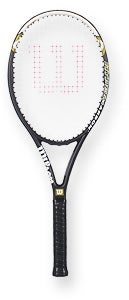Wilson Hyper Hammer 5.3 Stretch Racquet Review

The Hyper Hammer 5.3 enjoyed a kick-start during its introduction thanks to Tennis Magazine's 1999 Spring Gear Guide, where playtesters rated it as most powerful in its category. In Tennis Industry Magazine's Spring playtest the 5.3 Oversize ranked #2 overall, behind the Hyper Sledge Hammer 2.0 for men and women ranked 3.5-4.5. Not surprisingly, Wilson enjoyed impressive sell-in (initial sales to retailers) of this racquet and many players wondered if the 5.3 wasn't the holy grail of tennis. It quickly became Wilson's most popular selling Hyper Carbon model, and has enjoyed enhanced visibility on the pro tour in the hands of Lindsay Davenport and Todd Martin. Due to it's popularity, the 5.3 has also become Wilson's poster child for their newest material technology, Hyper Carbon, Wilson's answer to titanium racquets. The Hyper Hammer 5.3 continues to sell nicely for Wilson.
We playtested both headsizes of the Hyper Hammer 5.3 over a period of 2 weeks. Both racquets were re-strung midway through our playtest session at higher tensions. Strung at mid-range, both racquets (especially the Oversize) rocketed the ball off the stringbed, resulting in a lack of control. Our final tensions on both racquets were the maximum recommended by Wilson (Midplus @63 lbs. and Oversize@65 lbs.) with Wilson Sensation NXT 16.
Hyper Hammer 5.3 Midplus
On paper, the Hyper Hammer 5.3 Midplus seems to offer an ideal blend of power, control and maneuverability. At 27.5 inches, it provides a little more leverage and reach than a standard length racquet, without impeding reaction to balls hit close to the body. It's 95 square-inch head is control-oriented, while still offering adequate space for mis-hits. The combination of 10 ounces and a slightly (3 points) head-heavy balance make the 5.3 maneuverable, without feeling too feathery or hammery.
Its relatively light stationary weight can be misleading though. Dan explains, "this racquet swings heavier than 10 ounces. It has the stability of an 11.5 ounce, head-light player's racquet but the power of a true head-heavy model." Although the 5.3 midplus is slightly head-heavy, it's not as top-heavy as most other Hammer models. Granville offers, "on the plus side, this is a well-balanced, lightweight racquet. At 10 ounces, it has the same feel as a performance frame, but not quite the same power level. On the down side, this means it's like one of the original Isuzu Troopers - a big comfortable car with only 4 cylinders - a bit under powered. Better suited to 4.0-5.0 players." Don offers a little different take, "I liked this racquet's first moment, or static weight. It feels good just picking it up. In play though, the head feels a long way from the handle, resulting in more of a Hammer-effect than I like or the numbers would indicate. Although it's less head-heavy than other Hammers, it is no lightweight."
From the baseline, the 5.3 MP offers adequate power and favors players with medium to full swings who hit a flatter ball. Dan offers, "the denser string pattern will benefit flat ball strikers and string breakers. I had an extremely hard time generating any type of heavy spin. Players with longer swings, who rely on spin may find control problems here." Don concurs, "it was weird - the head seemed smaller than 95 square inches and the string pattern seemed denser than 16x20. I had difficulty hitting with much topspin or slice. Most of my groundies ended up flatter than usual, reducing my margin for error. Also, when I hit the sweetspot, everything felt great. Off-center shots, though, weren't very forgiving." Further testimony of the 5.3 midplus' 'tweener rating comes from Mark, who says, "this is either a powerful control racquet or a controlled power racquet - take your pick. A player using control racquets and seeking more power will like it, as will a player currently using a power racquet who wants more control."
Volleys are more powerful than groundstrokes with the 5.3 MP, according to our playtesters. Granville says, "while I did struggle a bit to drive my groundstrokes, I found the racquet gave me all the touch and comfort I expect at the net playing with my ProStaff 6.0 85, but with more pop." The 5.3 MP is quick and maneuverable at net but offers more stability than other 10 ounce racquets. Don explains, "I didn't experience the twisting problems at net that occurred on off-center grounstrokes and I definitely have plenty of mis-hit volleys. Either my volleys have improved (less likely) or the 5.3 MP's weighting provides good stability. I volleyed better than expected with this racquet." Dan, an aggressive net-player, offers, "volleys were crisp and the racquet's lighter weight lended itself well in situations needing quick reactions. My only problem was figuring out how short I should make my stroke. Volleys came flying off the stringbed with the slightest forward movement."
On serves, the 5.3 MP offers adequate power but spin is more difficult to generate than anticipated. Dan, a fast server, comments, "I give this racquet good scores in the power department, but again, the string pattern seemed to inhibit spin. Slicing out wide in the deuce court and topspin kick serves to the add court were tougher to hit than with comparable midplus racquets with more open string patterns. A solid frame for big servers who like to hit flat or intermediate level players looking for a boost in pace." Granville offers, "serves had good feel but lacked the pop to really power the ball. This lack of power might be improved by lowering string tension but then control on groundstrokes would be compromised." Don concludes, "I liked the increased leverage that the extra 1/2 inch provided. I felt more confident on first serves with the 5.3 MP, even if I wasn't hitting the ball any harder than usual. Second serves, though, required a more conscious application of spin to keep them from going long."
The 5.3 MP was quick and fairly stable on serve returns, approach shots and half-volleys. However, these shots require a full follow-through, otherwise they won't have enough juice, allowing your opponent to tee off on the next shot. Players who block or bunt the ball will probably find most of their balls falling short. Overheads can be hit with authority but you'll need to be set up and in position to take full advantage of the racquet's power.
The Hyper Hammer 5.3 Midplus is best suited to 4.0-5.0 players with medium-full to full swings. It offers good maneuverability and a nice combination of power and control. Drew's comments sum up the 5.3 MP best, "this racquet is very solid in all categories but no single attribute stands out as an exceptional strength or weakness. Like the Yonex SRQ Ti-700 Long and Head Ti S2, it's a good all-around racquet that will appeal to a broad range of players."
Hyper Hammer 5.3 Midplus Technical & Statistical Data
(Scores are determined by averaging individual play test scores)
|
|
||||||||||||||||||||||||||||||||||||
Hyper Hammer 5.3 Oversize Review
Although these racquets share the same name and cosmetics, the 5.3 Oversize is a very different racquet from the Midplus. The first impressions one gets when switching from the midplus to the oversize are its lighter weight and larger head. Unlike the midplus, whose head seems small and handle long, the oversize head seems larger than its 110 square inches, making the shaft and handle seem short. The midplus' slightly longer grip accentuates this effect. Granville describes it best, saying, "this 110 has the feel of a 135! This racquet seems almost unrelated to its smaller brother."
With the exception of Dan, our playtesters found the 5.3 OS noticeably more powerful than the midplus on groundstrokes. Dan comments, "when switching from a midplus to oversize in the same racquet model, you usually see a pretty significant boost in power and some loss of control. That wasn't the case here. Power levels were about the same but control was better. The more open string pattern allowed me to generate better spin, making control an easier proposition. This is one of the few oversize frames that I've liked better than its midplus counterpart."
While Dan's power perception matches the Babolat RDC Power ratings results (MP-56, OS-54) string tension plays a significant role here. Until we strung the 5.3 OS at max tension, it was difficult for players with a full swing to keep the ball in the court. Mark's comments at mid-tension, "this frame has a lot of power. I could also generate lots of spin. Actually, spin isn't an option with this racquet, it's a requirement! I felt like I had to swing straight up on my groundstrokes to keep the ball in the court. It reminded me of the old Hammer 5.5 Oversize - lots of power but difficult to control. When strung at 65 pounds, control was improved and more of my shots started dropping in." Keep in mind, players with shorter, slower swings will benefit more stringing the 5.3 OS at mid-range or lower.
Don also preferred the higher tension, offering, "at first (when strung at mid-tension), my groundstrokes were all flying long. I was forced to shorten my stroke and hit with excessive spin just to keep my shots from sailing. At max tension, I was able to hit through the ball more, without as many shots going long. The large, open stringbed packs plenty of boing, favoring players with more compact strokes. My slice backhand was a dream with this racquet though, providing lots of bite. A good choice for slice and dice players."
The 5.3 OS is easy to maneuver at net and its large head is fairly forgiving on mishits. It would be more stable on off-center shots but for its light weight. Drew explains, "I'm not a great volleyer to begin with and I found myself wanting to swing at volleys because the racquet lacked the stability to comfortably block the shots - of course, once you're swinging at volleys, you can forget about control and touch." Dan offers, "the oversize was easy to get around at net and manipulating spin on volleys was an easier task than with the midplus. There's still a lot of power here though. Players with good technique and short swings will enjoy volleying with this racquet. Less capable net players may find control problems."
Serving with the 5.3 OS is easy and most players who would use this racquet will enjoy good power. Big servers, though, will find the 5.3 OS is better for spin serves than for blasting aces. Dan comments, "serving was somewhat predictable. The lighter weight made it less stable and more difficult to generate any significant racquet head speed to crank the big one. Second serves dropped short and were weak if major head speed wasn't there. Good spin, though, due to the open string pattern." Don remarks, "the 5.3 OS will offer a serving advantage to players who don't normally serve hard. The large head and head-heavy balance don't require much effort to obtain good pace. Big servers, however, won't be able to whip this racquet around like smaller-headed frames. My best serves were slices out wide on the deuce court and topspin second serves. You can get some wicked spin on the ball."
At 9.2 ounces, the 5.3 OS is nimble on reaction shots, such as serve returns, stretched out groundstrokes, reaction volleys and half-volleys. The large, open stringbed also helps on touch and drop volleys. Slice approach shots can be very effective but must be hit with some authority to avoid pop-ups. Like serves, hitting overheads with the 5.3 is easy, especially for players who have less than perfect footwork and/or technique. You can still hit a winning overhead, even if you're not in just the right position or you're a little late getting the racquet in position.
Unlike the Hyper Hammer 5.3 Midplus, the 5.3 Oversize can be categorized as a game improvement racquet. Despite their similar RDC power ratings, the 5.3 OS provides more ball speed (power) from its 110 square inch, open stringbed. It's larger sweetspot also makes it more forgiving on off-center hits. We believe the Hyper Hammer 5.3 Oversize is best suited to 3.5-4.5 players with shorter swings and/or doubles specialists. It's light weight and large head make it ideal for quick doubles exchanges, especially for players seeking extra spin.
Hyper Hammer 5.3 Oversize Technical & Statistical Data
(Scores are determined by averaging individual play test scores)
|
|
||||||||||||||||||||||||||||||||||||
Playtester Profiles |
|
| Granville | 5.5 all-court player currently using a Wilson Pro Staff 6.0 85 |
| Dan | 5.5 all-court player currently using a Gamma Tradition 18 MP. |
| Mark | 5.5 serve & volleyer currently using a Prince Thunder Ultralite Titanium Oversize. |
| Don | 4.5-5.0 all-court player currently using a Pro Kennex Kinetic 5g Midplus. |
| Drew | 4.5-5.0 baseliner currently using a Wilson Pro Staff 6.0 85. |
Review date: November 1999. Hyper Hammer 5.3 Midplus test racquets strung with Tecnifibre NRG2 17 at 58 pounds. Hyper Hammer 5.3 Oversize test racquets strung with Tecnifibre NRG2 17 at 60 pounds. If you found this review interesting or have further questions or comments please contact us.
All content copyright 1999 Tennis Warehouse.










